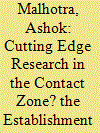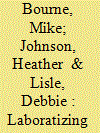|
|
|
Sort Order |
|
|
|
Items / Page
|
|
|
|
|
|
|
| Srl | Item |
| 1 |
ID:
178160


|
|
|
|
|
| Summary/Abstract |
By 1928, Robert McCarrison’s laboratories in the South Indian hill station of Coonoor had become recognised as the centre for nutritional research in India. Five years earlier, however, his institute had faced closure. This article argues that the establishment of McCarrison’s institute was based on his pitch to the Royal Commission on Agriculture in India in 1926, in which he successfully aligned his research to satisfy the concerns of various members of the Commission. This discussion uses McCarrison’s lobbying for his institute as a case study to examine the broader political manoeuvrings that colonial scientists in the early twentieth century often had to undertake to establish their research agendas.
|
|
|
|
|
|
|
|
|
|
|
|
|
|
|
|
| 2 |
ID:
140512


|
|
|
|
|
| Summary/Abstract |
This article critically interrogates how borders are produced by scientists, engineers and security experts in advance of the deployment of technical devices they develop. We trace how sovereign decisions are enacted as assemblages in the antecedent register of device development through the everyday decisions of scientists and engineers in the laboratory, the security experts they engage, and the material components of the device itself. Drawing on in-depth interviews, observations, and ethnographic research of the EU-funded Handhold project, we explore how assumptions about the way security technologies will and should perform at the border shape the development of a portable, integrated device to detect chemical, biological, radiological, nuclear and explosives (CBRNE) threats at borders. In disaggregating the moments of sovereign decision-making across multiple sites and times, we question the supposed linearity of how science comes out of and feeds back into the world of border security. An interrogation of competing assumptions and understandings of security threats and needs, of competing logics of innovation and pragmatism, of the demands of differentiated temporalities in detection and identification, and of the presumed capacities, behaviours, and needs of phantasmic competitors and end-users reveals a complex, circulating and co-constitutive process of device development that laboratises the border itself.
|
|
|
|
|
|
|
|
|
|
|
|
|
|
|
|
|
|
|
|
|